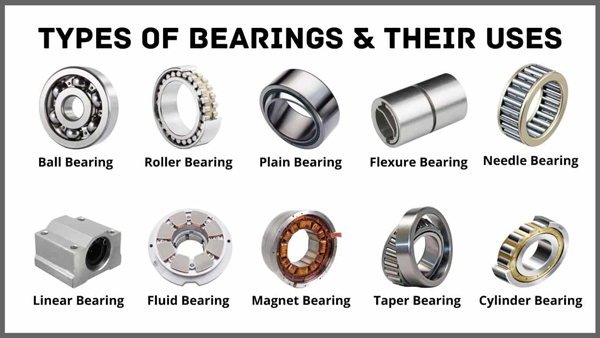Different Types of Machine Bearings
While there are many ways to improve machine bearings, one of the most common techniques is to make them smaller. As the size of machine bearings increases, the amount of friction will also increase, and this would increase the power consumption of the bearing. Instead of increasing the size, engineers can focus on developing new materials, optimising internal bearing geometry, and altering performance through lubricant choice.

Plain bearings
One of the major problems with plain machine bearings is oil whirl. This problem occurs when the rotor moves in an eccentric position over the oil film. This movement pumps up the oil and creates a high-pressure wedge that supports the load on the shaft. Since the upstream and downstream fluid pressures are different, there is a tangential force acting on the shaft and rotor. This force causes the rotor to vibrate. It is important to note that the frequency of oil whirl is directly related to the dragging speed of the fluid film.
Self-aligning bearings
Self-aligning machine bearings are designed to automatically adjust their positions in order to prevent misalignment. They can also be positioned in a manner that is optimal for machine performance. The design of the Self-Aligning Ball Bearing was developed by Sven Wingquist, a textile plant engineer from Sweden. He was studying the inefficiencies of the textile industry's machinery and found that the ball bearings used in machines were contributing to the inefficiency of the process. While ball bearings were originally designed to reduce friction, they were rigid and did not allow for flexibility when the parts were misaligned.
Deep groove bearings
Deep groove machine bearings are ball bearings with deep grooves in the ring. These bearings are used to support a large radial load. A radial load is defined as the weight of the object that the bearing supports divided by the radial distance between the balls and raceways.
Magnetic bearings
Magnetic machine bearings are used in machines, such as wind turbines, that require precise movement and balancing of the machine's components. They work by applying magnetic fields and currents to the machine to move it. Typically, the controller of a magnetic bearing consists of an amplifier and a position sensor. These sensors are used to monitor the rotor's position, and they produce error signals when it deviates from its nominal position.
Rolling bearings
A rolling bearing consists of inner and outer races, a cage and the rolling elements. The rolling elements create vibrations, either caused by wear and fatigue at the contact points, or from impacts, such as when one part strikes another. The location and frequency of the defects determine the level of vibrations generated.
Magnetic bearings with preload
Magnetic bearings are a versatile solution for machine bearings. They are not only more reliable than conventional bearings, but also less prone to catastrophic failure. Their use in centrifuges, canned pumps, turbo-expanders, and vacuum pumps is particularly advantageous. As early as 1994, some centrifugal compressors with powers up to 5000 kW were equipped with magnetic bearings. Furthermore, magnetic bearings can be controlled and calibrated to meet varying needs.











